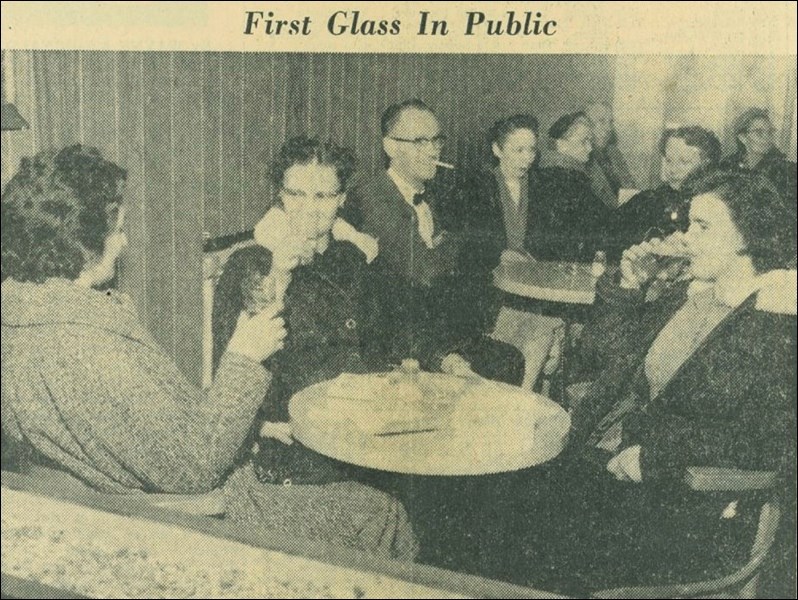When Jack and John Morrow opened the Shell Lake Hotel in 1957, only men were allowed in the beverage room. On Saturday nights, while the farmers were enjoying each other’s company in the bar, their wives often had nowhere to go. According to the Shell Lake local history book (1983), the Morrows made a tiny room in the hotel basement available where the women could visit without disturbing, or being disturbed by, the men. Saskatchewan beer parlours were men-only establishments until the early 1960s, when provincial liquor legislation permitted mixed drinking in newly christened “beverage rooms.”
Throughout 1958, the Saskatchewan’s Liquor Sales Outlet Inquiry Committee received 40 written briefs and heard 80 presentations from various organizations. Rev. T.E.J. Gibbon of the Saskatchewan Temperance Federation, for example, strongly opposed having women in beer parlours. “There are many nice women who would like to have a drink, no doubt,” Gibbon said, “but there are many of the other kind, and it would provide them with a nice, warm office.”
In March of 1959, the committee made three main recommendations: Beer parlours should be improved; the liquor act should be more strictly enforced; and there should be mixed drinking outlets. On April 1, 1959, the Liquor Licensing Act was passed by the provincial legislature. It established a process of local options votes whereby licensed dining rooms, cocktail bars and beverage rooms could be established in Saskatchewan communities. Women were allowed into these new liquor outlets. Regulations required that hotel make renovations to convert their beer parlours into beverage rooms in order to accommodate mixed drinking. Men-only beer parlours could continue to operate, but no beer parlour licenses would be issued to hotels not already licensed at the beginning of 1959.
Local option votes were held in 195 Saskatchewan communities in November 1959. Most of these communities voted “No” to the new types of liquor outlets. They would have to wait until 1964 before they could vote on the question again. Leask was one of the few villages in the province that voted “Yes.” On Feb. 11, 1960, the Saskatoon StarPhoenix reported that the Windsor Hotel in Leask opened the first beverage room in rural Saskatchewan. The 150-seat beverage room had been decorated in shades of mocha, rosewood and aqua, with matching furniture, receiving “general praise” for its appearance.
Millions of dollars were spent by the hotel owners of Saskatchewan to improve their licensed outlets. For example, Joe and Bernie Kaufman, owners of the Ponteix Hotel, made extensive renovations to convert their beer parlour into a beverage room in 1961. The result, the town’s local history book observes, was a more pleasant space that included a fountain, a large aquarium and carpeting throughout. Ab Montgomery, proprietor of the Tisdale Hotel, spent $60,000 enlarging and renovating his beverage room in 1964. The Regina Leader-Post reported that carpet, acoustic tile and inset lighting were installed, a new entrance was constructed and new tables and chairs were added to the Tisdale premises.
The new liquor law improved Saskatchewan’s drinking culture. At the 31st convention of the Hotels Association in 1962, Stewart told the delegates that, since the passage of the Liquor Licensing Act three years earlier, the overall standards of beverage rooms were “magnificent,” adding that women had lent the new drinking establishments “an air of decency.” A provincial government study of the drinking habits of residents in an unnamed town reported in 1963 that the “dire predictions that the new beverage outlet would sharply increase drinking in the community have not been fulfilled.”
It would take another 10 years before the last men-only bars disappeared in Saskatchewan. The StarPhoenix wrote on May 25, 1972 that the Warman Hotel and the Marchwell Hotel were the last two beer parlours in Saskatchewan that did not allow women to drink in their premises. Residents had consistently voted against mixed drinking in local option votes. Amendments to provincial liquor laws in 1972 changed the status of beer parlours and Vic Lynn, proprietor of the Warman Hotel, could finally take down the “Men Only” sign.



